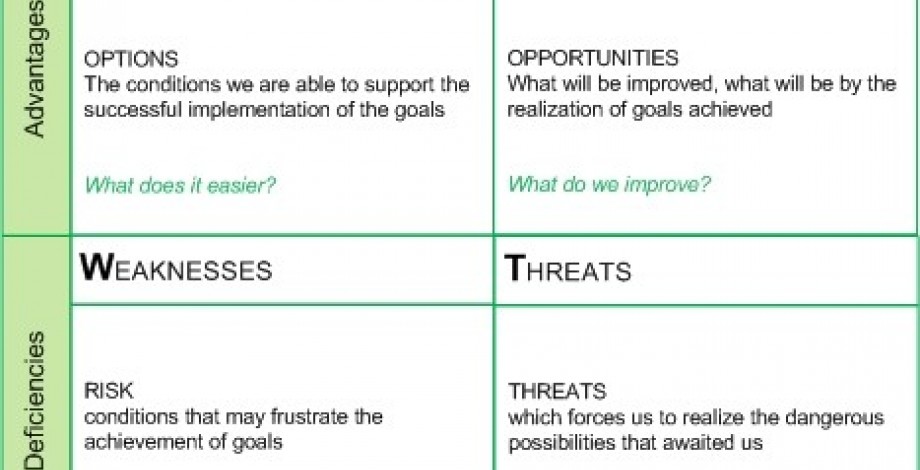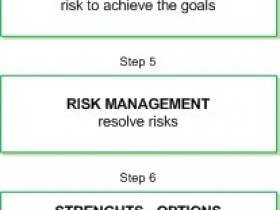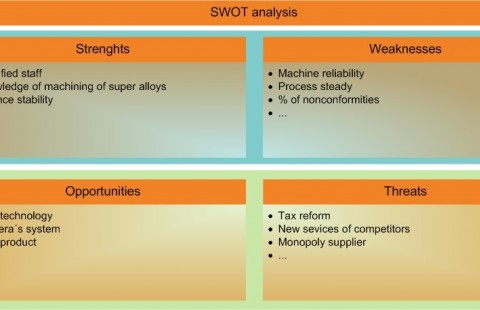On the top levels of management, particularly when medium-term and long-term strategic documents are being elaborated, information acquired through modern analytical methods is required ever more increasingly. These methods do not only work with data come from the traditional spheres, i.e. operating and economic data, but they also include qualitative data from the spheres of law, human resources and other. The results of these analyses are typically arranged into synoptic tables of expected benefits and potential risks. Detection of potential risks makes one part of the risk management.
The fundamental tool set down for detection of risks is the SWOT analysis which has been prescribed for government departments and some other public service bodies as a mandatory part of medium-term conceptions (see the Czech Government Decree no.10/2001). The SWOT analysis also makes a part of the EU bodies´ methodology for elaboration of strategic documents.
In order to understand problems of the SWOT analysis, we need to answer the following question first:
Is the SWOT analysis important?
The SWOT analysis was originally based upon the economic models drawn while looking for correlations between processes important for meeting of the set target. At the same time, both the quality of environment and the possibilities of the research subject are being taken into consideration. It signifies the items (indices) expressed in the SWOT analysis not only influence the meeting of the target, but are also interrelated. By eliminating the negative items you increase the chances that the target will be successfully met.
Blocks of the S-W-O-T analysis come in two manners of arrangements: vertical or horizontal. This way of arrangement corresponds to the fact the method was originally concieved in the economics to assess a company´s chances to penetrate into the market (target). That means the sequence was from the assessment of the company´s possibilities (S-W) to the assessment of the market (O-T). The company intends to make use of its abilities and establish itself in a particular environment, with the motive being ends chosen by the owner. In the course of the analysis, the company´s target can be modified to be matching its inner possibilities (strengths).
In order to meet the needs of the Public Service, a different procedure is used: from the assessment of the environment (T), through the assessment of the possibilities of the resolver (W-S), to reassessment of the environment (O). The Public Service intends to grow in strength in order to eliminate faults within the environment, its motives are social, politically-set targets. In the course of the analysis, the target set is nonchangeable by the resolver, the inner possibilities (strengths) have to be modified to fit the target.
The SWOT analysis for the Public Service - model procedure in steps
In order to make the SWOT analysis procedure more intelligible, the following model has been prepared which is applicable in the risk management of the Public Service where there are more (overall) targets and a large number of risks. Risks to be taken to meet the target are to be assessed, prioritized and resolved by means of the risk management system which is mandatory for the bodies of the Public Service (see § 25, Act no. 320/2001 of the Code).
step no.1 THREATS
deficiences in the environment that is under the authority of a Public Service body
step no.2 TARGET (OVERALL)
rectification of the deficiencies
step no.3 PARTIAL TARGETS
tasks to do in order to meet the (overall) target + criteria for meeting the target/tasks
step no.4 WEAKNESSES
risks faced in order to fulfil the target
step no.5 RISK MANAGEMENT
resolution of risks
step no.6 STRENGTHS
higher chances of meeting the target through the resolution of risks
step no.7 STRATEGY FOR ACHIEVEING THE TARGET/TASKS
procedure for meeting the target
step no.8 TARGET MET
target/tasks criteria met
step no.9 OPPORTUNITIES
better control over the environment that is in the sphere of competence of a Public Service body
In doing the SWOT analysis, it is essential to avoid making the obvious mistakes:
- Lists of items should not be compiled only formally, void of expertise and regardless of what really matters in reaching the target
- Items in the lists (T-W-S-O blocks) have to be prioritized.
- Lengthy lists of items have to be cut short according to the priorities.
- The SWOT analysis is not supposed to be done void of clearly defined partial targets/tasks, established priorities and criteria for meeting the target (step no.3).
- Priority risks (weaknesses) should not be ignored.
- External opportunities (opportunities) should not be mistaken for internal possibilities (strengths) of the solver institution.
- Strategy for reaching the target is supossed to be related to tasks expressed in the SWOT analysis and kept.
The SWOT analysis is often regarded as a strategy for meeting the target. However, this conclusion is wrong, as the analysis only describes situations for the assessment of which the strategies are yet to be set down. Steps nos. 1 to 6 are part of the analysis, steps nos. 7 and 8 are part of the strategy. A correctly-done SWOT analysis intelligibly defines possibilities of the solver institution.
It enables selection of an appropriate strategy for meeting the target. It points out the process priorities and, utilizing the risk management, makes it possible to use standard procedures and set down extraordinary measures to expedite achieving the target. By means of correctly-set criteria, it, then, enables an objective assessment of the continuous results.
The answer to the questions put at the beginning of this text is as follows:
The SWOT analysis makes a very significant tool for successful meeting of long-term targets.






